The researchers will focus on the regions of Silesia, Galicia, Burgenland and Istria. Source: Johana Wyss, Institute of Ethnology AV ČR, graphic editing by Vladimir Kotek.
Prague, Nov 23 (CTK) – The possible links between collective memory and the rising popularity of populist parties in border regions will be the focus of a project led by Johana Wyss from the Czech Academy of Sciences (AV ČR), and supported by a grant from the European Research Council (ERC).
The ERC will support the project with almost CZK 37 million, announced AV ČR, where Wyss, a social and cultural anthropologist, works in the Institute of Ethnology.
The researchers will focus on the regions of Silesia, Galicia, Burgenland and Istria.
According to AV ČR, the project could shed new light on the problem of populism, not only in Central and Eastern Europe.
Wyss said the rise of populist political parties can be seen across Europe. Most studies focus on populism-related conflicts in cities such as Prague, Warsaw and Budapest, she said, whereas her team will examine the often ignored border regions and their populations, and the reasons why locals support populist movements.
The common denominator of Silesia, Galicia, Burgenland and Istria is that they have all been through turbulent historical changes. In the past, their inhabitants were affected by changes in borders and their nationalities, and also by the deportation of inhabitants and atrocities inflicted upon them by armies crossing the borders.
At present, a rising support for populists can be seen in these regions. The scientists want to find and describe the connections between local people’s collective memory and their support for populist parties.
Wyss’s five-member team will spend one year examining the situation in the selected regions. They want to establish friendly relations, respect and confidence with the local people, Wyss said, emphasising that all data collected will be used anonymously.
Silesia is an area on the border of the Czech Republic, Poland and Germany, while Galicia lies on the border of Poland and Ukraine. Burgenland, now a part of Austria, belonged to the Kingdom of Hungary until the end of World War I, and now borders Hungary. Istria is split between the territory of Croatia, Slovenia and Italy.
Wyss said she had chosen areas that had experience with the Austro-Hungarian Empire. However, three of them also used to neighbour other European empires: Silesia was a neighbour of Prussia, Galicia of Tsarist Russia, and Istria of the Ottoman Empire.






